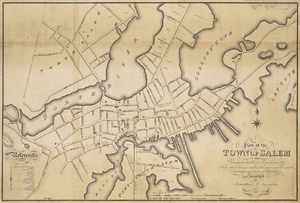The Witch House
|
Jonathan Corwin House | |
|
| |
| Part of | Chestnut Street District |
|---|---|
The Jonathan Corwin House in Salem, Massachusetts, USA, known as The Witch House, was the home of Judge Jonathan Corwin (1640–1718) and is the only structure still standing in Salem with direct ties to the Salem witch trials of 1692, thought to be built between 1620 and 1642. It was bought by Judge Corwin in 1675, when he was 35 years old, and he lived there for more than forty years. Corwin is buried in the nearby Broad Street Cemetery. The house remained in the Corwin family until the mid-19th century. It is located at 310 Essex Street, at the cross streets of North Street and Summer Street in the McIntire Historic District in Salem, Massachusetts.[1][2]
History
As a local magistrate and civic leader, Corwin was called upon to investigate the claims of diabolical activity when a surge of witchcraft accusations arose in Salem Village (now Danvers) and neighboring communities. He took the place of Judge Nathaniel Saltonstall, who resigned after the execution of Bridget Bishop. Corwin served on the Court of Oyer and Terminer, which ultimately sent nineteen people to the gallows. All nineteen refused to admit to witchcraft and steadfastly maintained their innocence.
The house is an excellent example of 17th-century New England architecture. Historians are still in some doubt as to when it was built. Corwin family lore maintains that it was built in 1642. Some Victorian scholars alleged that the house was built between 1620 and 1630 and that Roger Williams, founder of the Rhode Island colony, resided in the house in the 1630s.[3] However, the home's interpreters today state that Corwin bought an incomplete house in 1674 from Richard Davenport and the home was complete in 1675. The home in which Roger Williams and the Davenport families stayed was a different structure. It bears a strong resemblance to the Whitehall building in Cheam, England, a historic home (and now museum) built around 1500.
Despite rumors to the contrary, no interrogations or trials were ever conducted in the Witch House. There are no documents in which an accused is demanded to be brought to Judge Corwin's home, nor is it likely that the judge would have used his own home as a place to conduct legal proceedings of this nature. Interrogations were done at either the Old Meetinghouse or Ingersall's Tavern.
The house was moved about 35 feet (11 m) to its current location in the 1940s when the adjacent street was widened. At this time, it was restored to look as it would have in the 17th Century and the gambrel roof was altered. The house is now a museum operated by the City of Salem, and is open seasonally.[4]

See also
- List of historic houses in Massachusetts
- List of the oldest buildings in Massachusetts
- List of the oldest buildings in the United States
External links and references
- ↑ http://www.nytimes.com/2015/10/25/opinion/sunday/first-kill-the-witches-then-celebrate-them.html?_r=0 New York Times First, Kill the Witches. Then, Celebrate Them.
- ↑ http://www.nytimes.com/1991/09/09/us/salem-journal-the-witch-city-dusts-off-its-past.html New York Times Salem Journal; 'The Witch City' Dusts Off Its Past By MARY B. W. TABOR, Published: September 9, 1991
- ↑ Press Release, "THE WITCH HOUSE BEGINS ARCHITECTURAL HISTORY STUDY," 1/23/2008 (accessed July 14, 2008)
- ↑ http://www.latimes.com/travel/deals/la-trb-massachusetts-salem-witches-20151028-story.html Los Angeles Times
Coordinates: 42°31′17″N 70°53′56″W / 42.5215°N 70.8989°W
